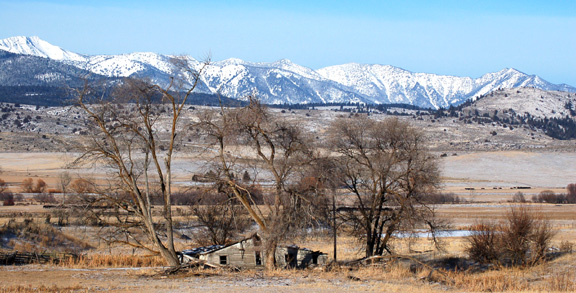- Public Lands Grazing Updates
----- Another Step Forward for Threatened Steelhead on the Malheur National Forest
----- Hell's Canyon Preservation Council Files Suit Asking Forest Service to Comply With the Law
----- ODFW Wolf Report
----- Krugman--A Tale of Two Moralities
[Edited 1/14-15 & 17/11]
_________
More time was taken with this post on livestock gazing, compared with others (:-)), simply because this is a subject that has been close to my heart and action for a long while, as is explained to some degree below.
Understanding the effects of livestock grazing is not really fully realized by reading a book--one has to go out over a period of time and look around, experience and get to know grazed and un-grazed environments--sit still, walk slowly, study, and soak up what is happening to living things in both situations. Looking at sometimes subtle (and often not so subtle) differences, such as in plant and animal diversity, the number of breeding birds or fish spawning locations (redds) found, stream morphology measurements such as width and depth, stream bank characteristics (overhanging or bare and laid back), the kinds, quantity and condition of riparian plants present, and much more, helps people understand the effects of livestock grazing on riparian/stream systems. The literature is rich with observations and conclusions, some of which have come from the scientists within the land management agencies (Forest Service, Bureau of Land Management, Fish and Wildlife Service, state wildlife agencies, and etc.) themselves.
The effects of livestock grazing are well know to many in addition to university professors, including in particular, the scientists in the federal and state agencies that manage our public lands. Conscientious and courageous agency biologists like Bill Platts, a now retired fisheries biologist in the Forest service pointed out some of the adverse effects many years ago. Most of the agencies own scientists today are well aware of these effects and more, but others in powerful and not so powerful positions, while under enormous political pressure to promote the grazing status quo, may bend to that pressure. Others, including even some with scientific training, eagerly enable bad grazing practices to continue, going so far as to ignore or defend them. Enormous amounts of taxpayer dollars are siphoned off and wasted so as to needlessly defend against lawsuits that properly target indefensible and destructive grazing practices, when taxpayer money should be aimed at monitoring the grazing activity and managing conditions on the ground--the public's ground. (I won't even be touching on the fact that public lands ranchers receive what amounts to a very large subsidy from US taxpayers--beginning with the woefully inadequate $1.35 monthly grazing fee for each cow and calf--so that ranchers can continue to have their way with the public lands.)
Here is one guarded example of many agency statements about the effects of livestock on riparian/stream systems:
Livestock Grazing in Riparian Areas in the Interior Columbia Basin and Portions of the Klamath and Great Basin; September 11, 1995
Within the western U.S., livestock grazing likely will continue as a primary use of much of the land area of the Columbia Basin (Kindschy 1994). Cattle are the principal type of livestock that now graze rangelands of the Columbia Basin. Riparian areas constitute only a small percentage of these rangelands (Bedell ed. 1993), yet livestock (especially cattle) activity is disproportionately concentrated within riparian areas (Marlow and Pogacnik 1986, Kovalchik and Elmore 1991) compared with upland areas of watersheds. Excessive herbage removal and physical damage by trampling are visual effects of improper grazing in riparian areas resulting from this concentration of activity. Less noticeable are effects on water quality.
Ramifications of excessive herbage removal and physical damage can include reduced dissipation of stream energy, increased bare soil and soil loss through accelerated erosion, stream channel degradation resulting in reduced floodplain recharge and/or lowered water table and subsequently reduced riparian community size. Erosion and stream channel degradation also affect water quality by increasing suspended sediments and, in conjunction with absence of vegetation shading, water temperature. Simplification of structural layering of vegetation, and presence of early successional stages result in less diverse and often less productive floral and faunal assemblages. Direct influences of livestock concentrations in riparian areas on water quality also include bacterial and protozoal parasite contamination and nutrient enrichment from fecal material in and near surface waters (Larsen in press).
To put that more simply, in lay people's terms: Poorly managed livestock grazing can easily trash riparian/stream systems (not to mention the uplands) on public lands, which are a natural heritage belonging to all the people of our sometimes United States.
For other environmental sources see:
Welfare Ranching: The Subsidized Destruction of the American West and Welfare Ranching: The Subsidized Destruction of the American West by George Wuerthner & Mollie Matteson.
Sacred cows at the public trough and Amazon
Effects of livestock grazing and trampling on aquatic and riparian habitats in the western United States
__
Another Step forward for Threatened Steelhead on the Malheur National Forest
On December 29, 2010, threatened native steelhead in the John Day River basin of Grant County received a New Year's gift from U.S. District Judge Ancer L. Haggerty and the steelhead's friends in the Oregon Natural Desert Association, the Center for Biological Diversity, Western Watersheds, and Advocates for the West.
Examples of grazing's effects on riparian/stream systems used by endangered fish like steelhead or bull trout.
 Summit Creek Exclosure--
Summit Creek Exclosure--Summit Creek on the Sagehen unit, Prairie City Ranger District. Photo shows example of healthy riparian and good fish habitat inside the exclosure. Note deep and narrow stream channel with ample bank stabilizing vegetation. The exclosure excludes cattle but not other native herbivores. I have personally witnessed elk jumping over the west fence into the exclosure to feed. The graminoids along the greenline were about 12 to 14 inches when this photo was taken on 10/08/06.

Summit Creek, just a hundred feet or so outside exclosure. Contrast this photo of this grazed portion of the creek with the previous photo showing conditions just upstream where cattle are excluded. ONDA folks listening to Tim Burton at Multiple Indicator Monitoring (MIM) field trip are Ken Stolz (rt.), Jefferson Jacobs (crouched, 2nd from end) and Mike Ogle (this side of Jefferson).
Note wide, shallower, unshaded stream, little bank stabilizing vegetation, and accelerated erosion from cattle shearing the overhanging bank on the right in photo above. Ex-Forest Service employee, now "consultant," Tim Burton (in the creek), who was conducting the seminar, had little to say about the cattle damage to the overhanging bank on the right. Of course it is hard to know exactly what the instructors said, as they told me to turn my video camera off before their educational program even got started. I was happy to help them find or identify some of the plants along this creek, as I have become quite familiar with this area over the years.
Malheur NF, Grant Co. OR, July 15, 2009
Tim Burton-Erv Cowley Shut Down Filming of their Malheur National Forest MIM Field Trip
Tim Burton, career retired government employee and fisheries biologist for the Forest Service and Bureau of Land Management (BLM), and Erv Cowley, retired career employee at the BLM, shut down filming of the field trip where they try explain their idea of Multiple Indicator Monitoring (MIM) to Malheur National Forest Service employees, ranchers, and other interested parties who are responsible for protecting streams from cattle grazing.
I guess they didn't want their methodologies under scrutiny, as Tim Burton was at the time helping the Forest Service defend themselves against a law suit by environmental groups who were trying to improve grazing management on the Malheur National Forest. Both Mr. Burton, and Mr. Cowley took their many years experience in the land management agencies, the kind of careers during which some employees get in bed with the ranchers, or at a minimum become totally inured to the damaging effects of livestock grazing, to propel themselves into their new job as monitoring "consultants."
While MIM monitoring is certainly a big step forward from what has been near total neglect, because the agencies will be unable to afford its implementation, it really just ends up providing a very thin veneer of professionalism and science over a failed grazing program.
Mr. Burton is leaning against the tailgate of the pick-up and Mr. Cowley is the one who came over to tell me to stop filming. Another individual in black cap and blue denim jeans, probably from the Forest service, came over to say something to them just before Cowley delivered his message to me. Here's your video Tim and Irv. You can watch it anytime you want on YouTube!
__
The victory for steelhead.
Here is the press release from the Center for Biological Diversity:
For Immediate Release, December 30, 2010
Contact:
Brent Fenty, ONDA, (541) 330-2638
Noah Greenwald, Center for Biological Diversity, (503) 484-7495
Jon Marvel, Western Watersheds Project, (208) 788-2290
Grazing Halted to Protect Steelhead Trout on a
Quarter-million Acres of Malheur National Forest
PORTLAND, Ore.— A federal judge today barred livestock grazing harmful to endangered steelhead trout on more than a quarter-million acres of public land on the Malheur National Forest in eastern Oregon. District Judge Ancer Haggerty ordered the U.S. Forest Service and National Marine Fisheries Service to reconsider the effects of the federal agencies’ grazing plan on native steelhead streams before grazing can resume.
According to Judge Haggerty, grazing has harmed steelhead by damaging the streams they depend on. The court’s order prohibits the Forest Service from allowing grazing on a vast area, including nearly 200 miles of critical steelhead habitat, until the agency complies with the Endangered Species Act. Along another 100 miles of steelhead streams, the court ordered the Forest Service to continue to carry out protective measures it approved during the last two years. The judge also ordered the Forest Service to comply with its steelhead habitat monitoring obligations under the National Forest Management Act and the Malheur Forest Plan before resuming grazing.
Today’s court order is the result of long-running challenges to Forest Service grazing by the Oregon Natural Desert Association, Center for Biological Diversity and Western Watersheds Project that began in 2003. It follows Judge Haggerty’s June 2010 ruling that the Forest Service’s grazing plan violated the Endangered Species Act and National Forest Management Act along more than 300 miles of steelhead streams in the John Day River Basin.
“Today’s decision puts the responsibility for protecting steelhead squarely on the agencies,” said Brent Fenty, ONDA’s executive director. “The court makes clear that the agencies have to make steelhead protection their highest priority, and that they cannot let riparian grazing continue until the agencies create a plan that complies with the law.”
In his ruling earlier this year, Judge Haggerty noted evidence that streamside grazing failed to meet ecological standards designed to conserve steelhead. The standards, established by the Forest Service and Fisheries Service, are meant to protect the key elements of healthy fish streams: stable stream banks and overhanging vegetation that keep streams clear and cold. The Forest Service’s grazing program has damaged stream banks much more severely than is allowed under federal standards.
“This decision insures that the Forest Service must give up its business-as-usual grazing management,” said Jon Marvel, executive director of Western Watersheds Project. “There will be no grazing on hundreds of miles of important fish streams until the Forest Service and NMFS can guarantee that grazing will not harm steelhead.”
Judge Haggerty’s order is the latest in a series of decisions that have resulted in significant protections for threatened steelhead. The judge issued a preliminary ruling in 2008 barring grazing on two allotments, which protected more than 90 miles of steelhead streams. In 2009, the court imposed strong conditions to restrict grazing and limit damage to streams. In the places where the court’s orders have prevented grazing during the past two years, even a single year of rest has allowed for significant initial recovery of riparian plant communities, stream channels and fish habitat.
“Suspending grazing on more than 200 miles of stream on the Malheur National Forest will not just benefit endangered steelhead, but numerous other wildlife species dependent on healthy rivers for their survival,” said Noah Greenwald, endangered species director at the Center for Biological Diversity. “It will also benefit the public by improving water quality and recreational opportunities, such as fishing, bird-watching and boating. Numerous studies have conclusively demonstrated that there is no compatible use of riparian areas by livestock.”
The Malheur National Forest is located in eastern Oregon’s Blue Mountains. It includes portions of the Upper John Day, Middle Fork John Day, North Fork John Day and Malheur rivers. The 281-mile long John Day River is the second longest undammed river in the continental United States. The river and its hundreds of miles of tributary streams on the Malheur National Forest provide spawning, rearing and migratory habitat for the largest naturally spawning, native stock of wild steelhead remaining in the Columbia River basin.
The opinion can be found at: http://onda.org/enforcing-conservation-laws/legal-actions/cases-1/pdf/07-1871%20Opinion%20and%20Order%20on%20Remedy%20%2812-30-10%29.pdf
Rumor has it that the defendants may have filed for a "Reconsideration" of Judge Haggerty"s opinion in this case.
__
 Beaver Dam Creek in 2007--Grazed condition
Beaver Dam Creek in 2007--Grazed conditionMurderer's Creek Allotment, Dan's Creek unit, Beaver Dam Creek and wet meadow. Photo shows low stubble and massive bank alteration. Cows had been on the unit for a while. Photo was taken on September 28, 2007.
 Beaver Dam Creek in 2008--Essentially ungrazed condition
Beaver Dam Creek in 2008--Essentially ungrazed conditionMurderer's Creek Allotment, Dan's Creek unit, Beaver Dam Creek and wet meadow. Photo shows high grass and sedge with little in the way of bank alteration. Cows were allegedly not here this year--just wild ungulates and feral horses. Photo was taken in September, 2008.
__
This case began in 2007, and was filed by the Oregon Natural Desert Association (ONDA), and their lawyers, Peter M. (Mac) Lacy (ONDA), Stephanie Parent (Pacific Environmental Advocacy Center, now also in private practice), and Kristin Ruether (Advocates for the West). It was subsequently led by David Becker (davebeckerlaw@gmail.com) who really brought success through his arduous effort which was well beyond the call of duty.
The progress in this case is documented at ONDA v. Kimbell et al., 07-1871-KI (Malheur National Forest grazing decisions).
Earlier attempts to improve grazing practices on the Malheur National Forest began under the direction of one of ONDA's founders and leading lights, Bill Marlett (along with Don Tryon and Alice Elshoff & others), when ONDA filed their first grazing lawsuit on the Malheur N.F. in the John Day/Camp Creek case back in 1994. Denzel and Nancy Ferguson were also early supporters, see: Sacred cows at the public trough and Amazon.
My own involvement in documenting livestock grazing damage on the Malheur began with feeble photographic attempts in 1999, when I first moved to Oregon. I had grown up in an area where the portions of the national forests I visited were not impacted by public lands livestock grazing. The streams that my father took me to for fishing and hiking were as natural as could be expected, with plenty of stream-shading shrubs to deal with, overhanging banks, and numerous pools where I could find some nice fish for dinner. Beginning in the early 1980's, during my jaunts to Utah, I began to notice that the streams, lakesides, and springs were being trashed by livestock grazing, with some areas taking on characteristics that resembled a stockyard. It was obvious that "Ecosystem management" had not yet become popular buzzwords within the land management agencies. In the mid-1980s western ecosystems and native plants became an interest, so I completed a field botany course in 1989, and began identifying and photographing native plants. Since the late 1980s I have observed and been deeply concerned about the destruction, including in some cases the permanent impairment and alteration, of western public ecosystems by livestock grazing.
I was, at least I like to think, a thorn in the side of the Forest Service and BLM, concerning their grazing practices, from the late 1980's on. The victories were almost non-existant, given that I had no lawyer and the BLM (Originally called the "Grazing Service" and "General Land Office"), as well as the Forest Service at that time, were actually at the beck and call of local ranching communities. In the rural ranching areas, both agencies did for all intents and purposes, function as a grazing service, protecting some ranchers' privileges to expropriate public land for use as an over-stocked private cow pasture. I used to go into the BLM district office in Fillmore, Utah, and find that the assistant district manager had articles from Range magazine on her office wall. The district manager was responsible for one allotment that was named for a relative, who bore his own last name. Similar agency kowtowing (or is that cowtowing?) and deplorable conditions were observed in California, Nevada and Arizona. Portions of the public lands in many areas of the rural west had clearly taken on the character of a stockyard.
 Stockyard? Bluebucket Allotment/Lake Camp Unit, Malheur National Forest. UTM 11T 0376580E 4883943N Black Canyon at end of trail from 460 road leading to spring & exclosure.
Stockyard? Bluebucket Allotment/Lake Camp Unit, Malheur National Forest. UTM 11T 0376580E 4883943N Black Canyon at end of trail from 460 road leading to spring & exclosure.Photo shows bare ground and erosion created by cattle trails and heavy use in the canyon around the exclosure. Sediments from sources like these will easily find their way downstream to seasonally used, threatened bull trout habitat, on the main stem of the Malheur River. Photo was taken on October 8, 2006.
Given my experiences, it was natural therefore to notice similar conditions on the Malheur National Forest when I moved to Prairie City, Oregon in 1999. My interest in monitoring public land grazing activities was well developed prior to my moving to Grant County in 1999, and so I immediately involved myself in continuing that activity. I attended agency-organized field tours, when allowed (they didn't always allow me to attend their "tours."), and reported incidents of cattle trespassing, violation of grazing standards, and areas of chronic damage caused by cattle grazing to the Forest Service. I also donated fencing material to the Prairie City district of the Malheur National Forest to help protect declining aspen stands from cattle grazing.
In 2000-2001, I teamed up with the Oregon Natural Desert Association, who had taken an interest in grazing activities on the Malheur not long after their founding in 1987. Jon Rhodes, Hydrologist at Planeto Azul Hydrology had already been on the case for some years, and soon, Dr. Bob Beschta, Professor Emeritus at Oregon State Universuity, who Jon has described as "perhaps the world's greatest living wildland hydrologist," along with renowned riparian ecologist, Dr. Boone Kauffman, and Grant County residents whose identity I should probably protect (unless given permission), were on the case. With that expertise, ONDA's lawyers, and my monitoring, we began an association aimed at getting the Malheur National Forest and their public land grazing permittees to begin following the law and to show the land a little respect in the John Day and Malheur River basins.
The first of a series of ONDA lawsuits that I was a party to began in 2003, with the most recent being the one that Judge Haggerty just rendered a decision in (2007). ONDA's legal efforts, along with court action, are beginning to improve livestock grazing management in both of these river systems. ONDA's actions, with the tremendous help of The Center For Biological Diversity, Western Watersheds, and Advocates For The West, have begun to see results, despite the enormous financial power arrayed against them, in protecting riparian corridors along the rivers and streams of these systems. As these riparian corridors begin to heal, the critters that inhabit them, including steelhead and breeding birds, among others, should begin to flourish and increase their numbers to a healthy sustainable level.
Much remains to be done by younger volunteers, both on the Malheur National Forest, and elsewhere. To help, please contact Oregon Natural Desert Association, the Center for Biological Diversity, Western Watersheds, and Advocates for the West.
 Grazed Condition in 2007
Grazed Condition in 2007Murderer's Creek Allotment/John Young Meadows Unit; S. Fk. Murderers Creek as it flows through John Young Meadows. Photo shows more massive trampling and mowed-down graminoids as poor conditions continue upstream from transectt south end of transect toward the horse pasture/exclosure and cow camp. Photo was taken on October 22, 2007.
 Un-grazed Condition in 2008
Un-grazed Condition in 2008Murderer's Creek Allotment/John Young Meadows Unit; S. Fk. Murderers Creek as it flows through John Young Meadows. Photo shows the effects of no cattle grazing, although feral horses and elk used the area. Bank alteration on transect measured was essentially non existant. Grazing permittee and ODFW employee are watching and photographing me from the road in upper right. Photo was taken in late October, 2008.
______
Hell's Canyon Preservation Council Files Suit Asking Forest Service to Comply With the Law
 USFS Feedlot-Juniper Flat, Juniper Flat pasture, Alder Springs allotment on the Whitman Ranger District, Wallowa-Whitman National Forest, Baker County, OR, (this allotment was among those categorically excluded from thorough environmental review and challenged in the lawsuit described in press release below). Photo by Christopher Christie, October 9, 2008
USFS Feedlot-Juniper Flat, Juniper Flat pasture, Alder Springs allotment on the Whitman Ranger District, Wallowa-Whitman National Forest, Baker County, OR, (this allotment was among those categorically excluded from thorough environmental review and challenged in the lawsuit described in press release below). Photo by Christopher Christie, October 9, 2008 Lawsuit Seeks to Protect Thousands of Acres of Public Lands and Waters from Forest Service's Inadequate Environmental Review of Livestock Grazing
The Hells Canyon Preservation Council and the Oregon Natural Desert Association filed a lawsuit in federal court challenging several Forest Service livestock grazing permit renewals on three National Forests in eastern Oregon. The Wallowa-Whitman, Umatilla and Malheur National Forests have together reauthorized livestock grazing on well over a quarter million acres of our public lands without thoroughly assessing or disclosing to the public the impacts of these actions on the region's natural resources.
Instead, the Forest Service has elected to forego any thorough environmental assessments or meaningful public participation, issuing numerous "categorical exclusions" across eastern Oregon and throughout the entire American West. An appropriations “rider” passed by Congress in 2005 and extended in 2008, allowed the Forest Service to categorically exclude grazing reauthorizations in fiscal years 2005 through 2008 from documentation under the National Environmental Policy Act (NEPA), if the agency was able to demonstrate with monitoring data that current grazing management is meeting resource standards (standards designed to ensure ecosystem health, protect native species, and prevent overgrazing). Categorical exclusions are also disallowed if grazing might negatively affect certain special resources like threatened and endangered species; flood plains, wetlands, or municipal watersheds; congressionally designated areas, such as wilderness or national recreation areas; and cultural or archeological sites.
The Forest Service has repeatedly misapplied this grazing rider across these three forests. Although grazing has occurred on these public lands allotments for decades, in most cases the Forest Service has never prepared any environmental analyses under NEPA, despite the presence of imperiled plants, threatened salmon and steelhead, degraded streams, sensitive and unique habitats, cultural and archeological sites, and areas designated by Congress for special resource protection, such as the Hells Canyon National Recreation Area and the Imnaha and John Day Wild & Scenic Rivers. Because the agency has failed to adequately monitor these areas and the resources they contain, it cannot show that protective standards are being met and that grazing does not pose any serious threats.
When inappropriately managed, livestock grazing adversely impacts ecological communities, particularly sensitive streamside areas, meadows, sagebrush ecosystems, aspen stands, and native grasses and forbs, all of which are critically important habitat for fish and wildlife. Livestock can trample and eat vegetation, spread noxious weeds, compact soils, erode streambanks and impair water quality. When livestock are allowed to degrade this habitat, it threatens the ecological functioning or survival of many fish, wildlife and plant species.
This action aims to ensure the Forest Service takes a hard look at the impacts of grazing on thousands of acres of public lands and waters, imperiled species, and countless other natural resources of eastern Oregon and gives the public a meaningful opportunity to participate in the decisions affecting our natural heritage.
______
ODFW Wolf Report from Michelle Dennehy
Imnaha Pack:
- at least 16 wolves
Imnaha Wolf Pack, December 30, 2010
____
Krugman--A Tale of Two Moralities
(A friend sent me this.)
A Tale of Two Moralities
By PAUL KRUGMAN
Published: January 13, 2011
On Wednesday, President Obama called on Americans to “expand our moral imaginations, to listen to each other more carefully, to sharpen our instincts for empathy, and remind ourselves of all the ways our hopes and dreams are bound together.” Those were beautiful words; they spoke to our desire for reconciliation.
But the truth is that we are a deeply divided nation and are likely to remain one for a long time.
. . . .
What are the differences I’m talking about?
One side of American politics considers the modern welfare state — a private-enterprise economy, but one in which society’s winners are taxed to pay for a social safety net — morally superior to the capitalism red in tooth and claw we had before the New Deal. It’s only right, this side believes, for the affluent to help the less fortunate.
The other side believes that people have a right to keep what they earn, and that taxing them to support others, no matter how needy, amounts to theft.
That’s what lies behind the modern right’s fondness for violent rhetoric: many activists on the right really do see taxes and regulation as tyrannical impositions on their liberty.
There’s no middle ground between these views. One side saw health reform, with its subsidized extension of coverage to the uninsured, as fulfilling a moral imperative: wealthy nations, it believed, have an obligation to provide all their citizens with essential care. The other side saw the same reform as a moral outrage, an assault on the right of Americans to spend their money as they choose. . . . .
It’s not enough to appeal to the better angels of our nature. We need to have leaders of both parties — or Mr. Obama alone if necessary — declare that both violence and any language hinting at the acceptability of violence are out of bounds. We all want reconciliation, but the road to that goal begins with an agreement that our differences will be settled by the rule of law.
My Edited Response:
The so-called "conservatives" (certainly not my conservative side) think their breaks in life make them superior, and entitle them to be actually haughty and vicious--to rationalize that the needy are simply "bad" people. It appears that they have no understanding of a simple truth: "There but for fortune go you and I."
As far as empathy, violence, the rule of law, and reconciliation goes, perhaps the first step is for America (and Obama) to set an example, by ending the state terrorism we afflict on others in illegal, useless, wasteful, counter-productive and destructive wars, and, most importantly, the infliction of tragic violence and murder on innocent people around the globe. All talk about violence being inappropriate seems a little hypocritical and inconsistent in the face of our own country's very violent ways.
[See next post:
MONDAY, JANUARY 17, 2011]
A Day To Remember Martin Luther King Jr.
Chris












3 comments:
Great Newsletter! Enjoyed every line. Keep it up!
Brian L. Horejsi
Thanks Brian.
Thanks also for your work with grizzly bear recovery in southern Alberta.
http://www.banffcentre.ca/mountainculture/mtnconferences/eesma/abstract/horejsi.htm
Chris
Two other articles by Dr. Horejsi:
The Fate of Alberta's Grizzly Bears (http://www.counterpunch.org/horejsi06292010.html)
Wind Turbines; Offensive industrialization of human space
By Online Monday, July 28, 2008
By: Dr. Brian L. Horejsi, Dr. Barrie K. Gilbert, George Wuerthner
(http://www.canadafreepress.com/index.php/article/4163)
Post a Comment